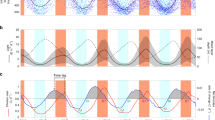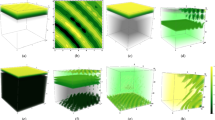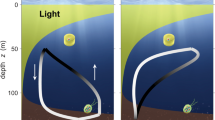Abstract
Phytoplankton size structure is acknowledged as a fundamental property determining energy flow through ‘microbial’ or ‘herbivore’ pathways1. The balance between these two pathways determines the ability of the ecosystem to recycle carbon within the upper layer or to export it to the ocean interior1. Small cells are usually characteristic of oligotrophic, stratified ocean waters, in which regenerated ammonium is the only available form of inorganic nitrogen and recycling dominates. Large cells seem to characterize phytoplankton in which inputs of nitrate enter the euphotic layer and exported production is higher2,3,4. But the size structure of phytoplankton may depend more directly on hydrodynamical forces than on the source of available nitrogen5,6,7. Here we present an empirical model that relates the magnitude of mesoscale vertical motion to the slope of the size–abundance spectrum8,9,10 of phytoplankton in a frontal ecosystem. Our model indicates that the relative proportion of large cells increases with the magnitude of the upward velocity. This suggests that mesoscale vertical motion—a ubiquitous feature of eddies and unstable fronts—controls directly the size structure of phytoplankton in the ocean.
This is a preview of subscription content, access via your institution
Access options
Subscribe to this journal
Receive 51 print issues and online access
$199.00 per year
only $3.90 per issue
Buy this article
- Purchase on Springer Link
- Instant access to full article PDF
Prices may be subject to local taxes which are calculated during checkout



Similar content being viewed by others
References
Legendre, L. & Le Fèvre, J. in Productivity of the Ocean: Present and Past (eds Berger, W. H., Smetaceck, V. S. & Wefer, G.) 49–63 (John Wiley & Sons Limited, New York, 1989).
Eppley, R. W. & Peterson, B. J. Particulate organic matter flux and planktonic new production in the deep ocean. Nature 282, 677–680 (1979).
Malone, T. C. in The Physiological Ecology of Phytoplankton (ed. Morris, I.) 433–464 (Blackwell Scientific Publications, Oxford, 1980).
Chisholm, S. W. in Primary Productivity and Biogeochemical Cycles in the Sea (eds Falkowski, P. G. & Woodhead, A. D.) 213–237 (Plenum, New York, 1992).
Semina, H. J. Water movement and the size of phytoplankton cells. Sarsia 34, 267–272 (1968).
Semina, H. J. The size of phytoplankton cells in the Pacific Ocean. Int. Revue ges. Hidrobiol. 57, 177–205 (1972).
Peña, A., Lewis, M. R. & Harrison, G. Primary productivity and size structure of phytoplankton biomass on a transect of the equator at 135°W in the Pacific Ocean. Deep-Sea Res. 37, 295–315 (1990).
Platt, T. & Denman, K. H. The structure of pelagic marine ecosystems. Rapp. P.-V. Reun. Cons. Int. Explor. Mer 173, 60–65 (1978).
Rodríguez, J. & Mullin, M. M. Relation between biomass and body weight of plankton in a steady state oceanic ecosystem. Limnol. Oceanogr. 31, 361–370 (1986).
Rodríguez, J. & Li, W. K. W. (eds) The size structure and metabolism of the pelagic ecosystem. Scientia Marina 58, 1–167 (1994).
Strass, V. H. Chlorophyll patchiness caused by mesoscale upwelling at fronts. Deep-Sea Res. 39, 75–96 (1992).
Harris, G. P., Ganf, G. G. & Thomas, D. P. Productivity, growth rates and cell size distributions of phytoplankton in the SW Tasman Sea: implications for carbon metabolism in the photic zone. J. Plankton Res. 9, 1003–1030 (1987).
Rodríguez, J. et al. Patterns in the size structure of phytoplankton community in the deep fluorescence maximum of the Alboran Sea (southwestern Mediterranean). Deep-Sea Res. 45, 1577–1593 (1998).
Smayda, T. J. The suspension and sinking of phytoplankton in the sea. Oceanogr. Mar. Biol. Annu. Rev. 8, 353–414 (1970).
Leach, H. The diagnosis of synoptic-scale vertical motion in the seasonal thermocline. Deep-Sea Res. 34, 2005–2017 (1987).
Tintoré, J., Gomis, D., Alonso, S. & Parrilla, G. Mesoscale dynamics and vertical motion in the Alboran Sea. J. Phys. Oceanogr. 21, 811–823 (1991).
Allen, J. T. & Smeed, D. A. Potential vorticity and vertical velocity at the Iceland Faroes front. J. Phys. Oceanogr. 26, 2611–2634 (1996).
Cullen, J. J. The deep chlorophyll maximum: comparing vertical profiles of chlorophyll a. Can. J. Fish. Aquat. Sci. 39, 791–803 (1982).
Furuya, K. & Marumo, R. The structure of the phytoplankton community in the subsurface chlorophyll maxima in the western North Pacific Ocean. J. Plankton Res. 5, 393–406 (1983).
Estrada, M. et al. Variability of deep chlorophyll maximum characteristics in the Northwestern Mediterranean. Mar. Ecol. Prog. Ser. 92, 289–300 (1993).
Ruiz, J., García, C. M. & Rodríguez, J. Vertical patterns of phytoplankton size distribution in the Cantabric and Balearic seas. J. Mar. Systems 9, 269–282 (1996).
Fiekas, V., Leach, H., Mirbach, K.-J. & Woods, J. D. Mesoscale inestability and upwelling. Part 1: Observations at the North Atlantic intergyre front. J. Phys. Oceanogr. 24, 1750–1758 (1994).
Viúdez, A., Tintoré, J. & Haney, R. L. Circulation in the Alboran Sea as determined by quasi-synoptic hydrographic observations. I. Three dimensional structure of the two anticyclonic gyres. J. Phys. Oceanogr. 26, 684–705 (1996).
Pollard, R. T. & Regier, L. Large variations in potential vorticity at small spatial scales in the upper ocean. Nature 348, 227–229 (1990).
Allen, J. T., Smeed, D. A., Nurser, A. J. G., Zhang, J. W. & Rixen, M. Diagnosing vertical velocities with the QG omega equation: an examination of the errors due to sampling strategy. Deep-Sea Res. (in the press).
Cushman-Roisin, B. Introduction to Geophysical Fluid Dynamics (Prentice-Hall, Englewood Cliffs, New Jersey, 1994).
Gomis, D., Ruíz, S. & Pedder, M. A. Diagnostic analysis of the 3D ageostrophic circulation from a Multivariate Spatial Interpolation of CTD and ADCP data. Deep-Sea Res. 48, 269–295 (2000).
Acknowledgements
This work was supported by the MAST III programme of the European Commision and the CICYT-CYTMAR programme (Spain). We thank M. Emelianov for translating the Russian work of H. J. Semina. We also thank the officers, technicians and crew of BIO Hesperides for their help during the OMEGA cruise.
Author information
Authors and Affiliations
Corresponding author
Rights and permissions
About this article
Cite this article
Rodríguez, J., Tintoré, J., Allen, J. et al. Mesoscale vertical motion and the size structure of phytoplankton in the ocean. Nature 410, 360–363 (2001). https://doi.org/10.1038/35066560
Received:
Accepted:
Issue Date:
DOI: https://doi.org/10.1038/35066560
This article is cited by
-
Estimating Photosynthetically Active Euphotic Layer in Major Lakes of Kumaun Region Using Secchi Depth
Water, Air, & Soil Pollution (2023)
-
Regulation of Low and High Nucleic Acid Fluorescent Heterotrophic Prokaryote Subpopulations and Links to Viral-Induced Mortality Within Natural Prokaryote-Virus Communities
Microbial Ecology (2020)
-
Intermediate-size cell dominance in the phytoplankton community of an eutrophic, estuarine ecosystem (Guadalhorce River, Southern Spain)
Hydrobiologia (2020)
-
Microscopic view of phytoplankton along the Yangtze River
Science China Technological Sciences (2019)
-
Changes in the plankton community according to oceanographic variability in a shallow subtropical shelf: SW Atlantic
Hydrobiologia (2019)
Comments
By submitting a comment you agree to abide by our Terms and Community Guidelines. If you find something abusive or that does not comply with our terms or guidelines please flag it as inappropriate.



